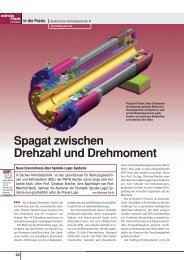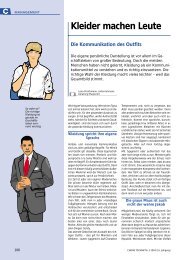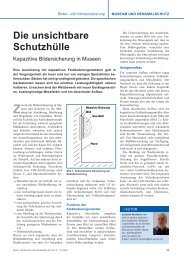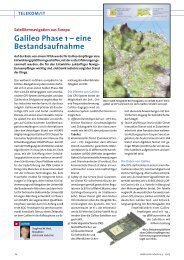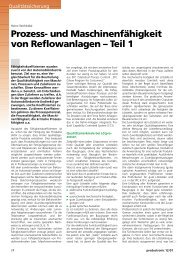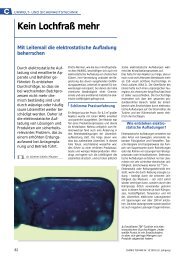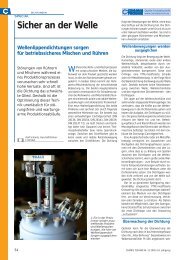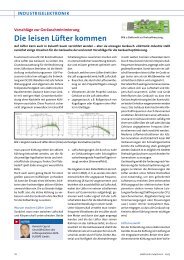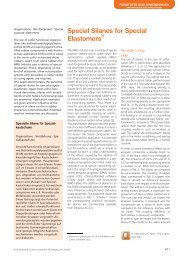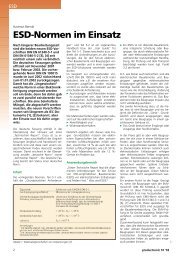A Review of Recent Progress in the Design and ... - Neue Verpackung
A Review of Recent Progress in the Design and ... - Neue Verpackung
A Review of Recent Progress in the Design and ... - Neue Verpackung
Create successful ePaper yourself
Turn your PDF publications into a flip-book with our unique Google optimized e-Paper software.
ROHSTOFFE UND ANWENDUNGEN<br />
RAW MATERIALS AND APPLICATIONS<br />
Fluoroelastomers Base resistance <br />
Competitive dehydr<strong>of</strong>luor<strong>in</strong>ation <br />
F-19 NMR 3,3,3-trifluoropropene<br />
Increas<strong>in</strong>gly basic formulations <strong>of</strong><br />
automotive lubricants have required<br />
that new heat- <strong>and</strong> oil- resistant elastomers<br />
be developed. The reactivity <strong>of</strong><br />
VF2-based elastomers <strong>in</strong> solution is<br />
exam<strong>in</strong>ed <strong>in</strong> an NMR-monitored study<br />
<strong>and</strong> compared to that <strong>of</strong> VF2-free<br />
fluoroelastomers. It was found that<br />
that a VF2-free elastomer based on TFE<br />
<strong>and</strong> P that conta<strong>in</strong>s curesite levels <strong>of</strong><br />
3,3,3-trifluoropropene responds very<br />
well to basic vulcanization with bisphenols<br />
<strong>and</strong> yet affords outst<strong>and</strong><strong>in</strong>g<br />
resistance toward base <strong>in</strong> service <strong>and</strong> <strong>in</strong><br />
competitive dehydr<strong>of</strong>luor<strong>in</strong>ation<br />
studies <strong>in</strong> solution. This desirable<br />
behavior is attributed to <strong>the</strong> high reactivity<br />
<strong>of</strong> <strong>the</strong> curesite monomer <strong>and</strong><br />
to its limited concentration.<br />
E<strong>in</strong> Fortschrittsbericht zum<br />
Aufbau und den Reaktionen<br />
Laugenstabiler Fluorelastomere<br />
Fluorelastomere Laugenstabilität <br />
Dehydr<strong>of</strong>luorierung F-19 NMR <br />
3,3,3-Trifluorpropen<br />
Die zunehmend basische Rezepturierung<br />
von Schmierst<strong>of</strong>fen im Automobilbereich<br />
erfordert die Entwicklung<br />
neuer hitze- und ölbeständiger<br />
Elastomere. Die Reaktivität<br />
von Flurelastomeren die auf VF2-<br />
Basis hergestellt wurden, ist vergleichend<br />
mit Hilfe von NMR untersucht<br />
worden. Es wurde gefunden,<br />
dass VF2 – freie Elastomere die<br />
TFE und TFP enthalten sehr gut mit<br />
basischen Bis – Phenolen vernetzt<br />
werden können und zudem e<strong>in</strong>en<br />
außergewöhlichen Widerst<strong>and</strong> gegen<br />
Basen im Gebrauch oder gegen<br />
Dehydr<strong>of</strong>luorierung <strong>in</strong> Lösung aufweisen.<br />
Dieses erwünschte Eigenschaftsbild<br />
wird der hohen Reaktivität<br />
des Curesite-Monomeren und<br />
se<strong>in</strong>er ger<strong>in</strong>gen Konzentration zugeschrieben.<br />
A <strong>Review</strong> <strong>of</strong> <strong>Recent</strong> <strong>Progress</strong> <strong>in</strong><br />
<strong>the</strong> <strong>Design</strong> <strong>and</strong> Reactions <strong>of</strong><br />
Base-Resistant Fluoroelastomers<br />
The ease <strong>of</strong> proton abstraction from carbon-hydrogen<br />
compounds that are partially<br />
fluor<strong>in</strong>ated is a specific function <strong>of</strong> structure.<br />
Poly(v<strong>in</strong>ylidene fluoride) (VF2) <strong>and</strong><br />
isomeric, alternat<strong>in</strong>g tetrafluoroethylene<br />
(TFE)/ethylene (E) are opposites <strong>in</strong> terms<br />
<strong>of</strong> polarity, solubility <strong>and</strong> base-resistance.<br />
The homopolymer is highly reactive <strong>and</strong><br />
soluble <strong>in</strong> donor solvents like acetone,<br />
while <strong>the</strong> copolymer is essentially <strong>in</strong>ert to<br />
bases <strong>and</strong> only soluble <strong>in</strong> fluorocarbons.<br />
Elastomeric examples <strong>of</strong> such reactivity differences<br />
are <strong>the</strong> family <strong>of</strong> VF2-based copolymers<br />
<strong>of</strong> hexafluoropropylene (HFP) or<br />
perfluoro(methyl v<strong>in</strong>yl e<strong>the</strong>r) (PMVE), or<br />
<strong>the</strong>ir terpolymers with TFE, <strong>and</strong> <strong>the</strong> family<br />
<strong>of</strong> VF2-free copolymers <strong>of</strong> TFE <strong>and</strong> propylene<br />
(P) or terpolymers <strong>of</strong> TFE, PMVE, <strong>and</strong><br />
E. Clearly, fluor<strong>in</strong>e content alone is a poor<br />
predictor <strong>of</strong> base resistance. Despite <strong>the</strong>ir<br />
long demonstrated outst<strong>and</strong><strong>in</strong>g heat <strong>and</strong><br />
oil resistance generally, <strong>and</strong> good acid resistance<br />
when crossl<strong>in</strong>ked by peroxides,<br />
VF2-based fluoroelastomers are <strong>in</strong>tr<strong>in</strong>sically<br />
highly reactive toward soluble bases. It is<br />
an <strong>in</strong>escapable fact that amorphous fluoroelastomers<br />
<strong>of</strong> <strong>the</strong> VF2/HFP/TFE <strong>and</strong><br />
VF2/PMVE/TFE families can not be made<br />
resistant to gross dehydr<strong>of</strong>luor<strong>in</strong>ation<br />
<strong>and</strong> subsequent embrittlement due to<br />
overcrossl<strong>in</strong>k<strong>in</strong>g on contact with strong<br />
nucleophilic bases. This is a consequence<br />
<strong>of</strong> <strong>the</strong> high VF2 levels required to achieve<br />
acceptably low glass transition temperatures<br />
<strong>and</strong> <strong>the</strong> high levels <strong>of</strong> HFP or PMVE<br />
required to prevent VF2, or mixed VF2/<br />
TFE, crystall<strong>in</strong>ity. Even tetrapolymers that<br />
use E to partially replace VF2 are not<br />
base-resistant but merely possess a somewhat<br />
reduced, yet still too-high, concentration<br />
<strong>of</strong> highly base-sensitive Rf – VF2 –<br />
Rf sequences. It should not be surpris<strong>in</strong>g<br />
that elastomers that can be crossl<strong>in</strong>ked<br />
<strong>in</strong> less than one m<strong>in</strong>ute at 200C <strong>and</strong><br />
have a large excess <strong>of</strong> such Rf – VF2 – Rf<br />
curesites due to morphological requirements,<br />
are not able to withst<strong>and</strong> <strong>the</strong> attack<br />
<strong>of</strong> similarly basic species <strong>in</strong> service. Instead,<br />
<strong>the</strong> hydrogen content <strong>of</strong> affordable baseresistant<br />
fluoroelastomers required for flexibility<br />
<strong>in</strong> low temperature service must be<br />
provided by hydrocarbon olef<strong>in</strong>s like E or P.<br />
Such structures <strong>the</strong>n confer <strong>the</strong> <strong>in</strong>ertness<br />
toward _bases that characterize TFE/E ra<strong>the</strong>r<br />
than poly(VF2). Elastomeric compositions<br />
that possess this superior level <strong>of</strong><br />
base-resistance are TFE/P/curesite monomer<br />
<strong>and</strong> TFE/PMVE/E/curesite monomer.<br />
Development <strong>of</strong><br />
Fluoroelastomers<br />
The early development <strong>of</strong> fluoroelastomers<br />
is described <strong>in</strong> a general reference [1]. Research<br />
<strong>in</strong> <strong>the</strong> mid 1950s by DuPont [2] <strong>and</strong><br />
M. W. Kellogg [3] (later acquired by 3M)<br />
led to a major advance <strong>in</strong> <strong>the</strong> <strong>the</strong>rmal stability<br />
<strong>and</strong> oil resistance <strong>of</strong> elastomers useful<br />
for seal<strong>in</strong>g applications under severe conditions.<br />
Attempts to cure <strong>the</strong>se early compositions<br />
<strong>of</strong> VF2/HFP [4] <strong>and</strong> VF2/CTFE [3]<br />
showed that <strong>the</strong>y were unresponsive to<br />
peroxides but reactive toward soluble bases.<br />
Initial cur<strong>in</strong>g systems for VF2/HFP<br />
used tertiary am<strong>in</strong>es as dehydr<strong>of</strong>luor<strong>in</strong>at<strong>in</strong>g<br />
agents <strong>and</strong> dithiols as bisnucleophiles.<br />
Primary diam<strong>in</strong>es were found to be reasonably<br />
scorch resistant curatives when used<br />
<strong>in</strong> <strong>the</strong> form <strong>of</strong> <strong>the</strong>ir carbamate or Schiff’s<br />
base derivatives <strong>in</strong> <strong>the</strong> presence <strong>of</strong> <strong>in</strong>organic<br />
acid acceptors such as MgO <strong>and</strong><br />
Ca(OH) 2 . Commercial curatives were<br />
developed from <strong>the</strong> carbamates <strong>of</strong> ethylene<br />
diam<strong>in</strong>e <strong>and</strong> 1,6-hexamethylenediam<strong>in</strong>e<br />
<strong>and</strong> <strong>the</strong> bis-c<strong>in</strong>namaldehyde condensation<br />
product <strong>of</strong> <strong>the</strong> hexamethylene<br />
diam<strong>in</strong>e [4]. To fur<strong>the</strong>r <strong>in</strong>crease fluor<strong>in</strong>e<br />
content <strong>and</strong> raise fluids resistance, DuPont<br />
developed <strong>and</strong> commercialized TFE-contai-<br />
W. W. Schmiegel, Wilm<strong>in</strong>gton (USA)<br />
Corresond<strong>in</strong>g author:<br />
Walter W. Schmiegel<br />
DuPont Dow Elastomers LLC<br />
DuPont Experimental Station<br />
Wilm<strong>in</strong>gton, DE 19800-0293 USA<br />
KGK Kautschuk Gummi Kunstst<strong>of</strong>fe 57. Jahrgang, Nr. 6/2004 313
n<strong>in</strong>g terpolymers <strong>of</strong> VF2/HFP soon after <strong>the</strong><br />
dipolymers were commercialized [5]. Barred<br />
from us<strong>in</strong>g HFP, Montecat<strong>in</strong>i Edison<br />
entered <strong>the</strong> fluoroelastomer field with<br />
VF2 copolymers <strong>of</strong> 1-H-pentafluoropropene<br />
[6, 7]. However, <strong>the</strong>se were less <strong>the</strong>rmally<br />
stable <strong>and</strong> solvent resistant than<br />
correspond<strong>in</strong>g HFP dipolymers <strong>and</strong> terpolymers<br />
<strong>and</strong> were subsequently replaced by<br />
HFP analogs upon expiration <strong>of</strong> orig<strong>in</strong>al<br />
patents [8].<br />
A major advance <strong>in</strong> cur<strong>in</strong>g chemistry was<br />
made <strong>in</strong> <strong>the</strong> late 1960s when it was found<br />
that, <strong>in</strong> <strong>the</strong> presence or <strong>in</strong>organic acid acceptors,<br />
alkali salts <strong>of</strong> bisphenols could be<br />
used as bisnucleophilic crossl<strong>in</strong>k<strong>in</strong>g agents<br />
<strong>in</strong> <strong>the</strong> presence <strong>of</strong> a non-ionic phase transfer<br />
catalyst (18-crown-6) [9] <strong>and</strong> ultimately<br />
as free bisphenols with quaternary ammonium<br />
<strong>and</strong> phosphonium salts as phase<br />
transfer catalysts [10]. The change from aliphatic<br />
primary diam<strong>in</strong>es to bisphenol<br />
anions as <strong>the</strong> active crossl<strong>in</strong>k<strong>in</strong>g species resulted<br />
<strong>in</strong> vast improvements <strong>in</strong> process<strong>in</strong>g<br />
safety <strong>and</strong> high temperature compression<br />
set resistance, as well as <strong>in</strong> major improvements<br />
<strong>in</strong> <strong>the</strong> stability <strong>of</strong> tensile properties<br />
on heat ag<strong>in</strong>g, <strong>and</strong> <strong>in</strong> greatly improved hydrolytic<br />
stability. Bis-phenyl e<strong>the</strong>r crossl<strong>in</strong>ks,<br />
even if l<strong>in</strong>k<strong>in</strong>g unsaturated sites <strong>of</strong><br />
<strong>the</strong> fluoroelastomer, are far more stable<br />
than bis-im<strong>in</strong>e crossl<strong>in</strong>ks that are sensitive<br />
to electrophilic oxidants <strong>and</strong> that can also<br />
regenerate <strong>the</strong> active crossl<strong>in</strong>k<strong>in</strong>g agent on<br />
hydrolysis when exposed to steam or boil<strong>in</strong>g<br />
water for extended periods. The diam<strong>in</strong>e<br />
networks are <strong>the</strong>refore relatively unstable,<br />
undergo<strong>in</strong>g a ’march<strong>in</strong>g modulus’<br />
process on heat ag<strong>in</strong>g <strong>in</strong> ambient air <strong>and</strong><br />
suffer<strong>in</strong>g from a loss <strong>of</strong> crossl<strong>in</strong>k density<br />
on exposure to low pressure steam. Even<br />
bisphenol-cured vulcanizates are considerably<br />
s<strong>of</strong>tened by <strong>the</strong> swell<strong>in</strong>g <strong>of</strong> <strong>in</strong>organic<br />
bases <strong>in</strong> contact with steam or aqueous<br />
acids <strong>and</strong> <strong>the</strong> best cur<strong>in</strong>g systems for resistance<br />
to such exposures are based on peroxides<br />
<strong>and</strong> radical traps when used with<br />
fluoroelastomers that conta<strong>in</strong> a brom<strong>in</strong>e<br />
or iod<strong>in</strong>e cure site. This is not necessarily<br />
<strong>the</strong> result <strong>of</strong> a more stable crossl<strong>in</strong>k <strong>and</strong><br />
a saturated backbone, however. Instead,<br />
it appears also to be a strong function <strong>of</strong><br />
<strong>the</strong> reduced level <strong>and</strong> basicity <strong>of</strong> <strong>the</strong> <strong>in</strong>organic<br />
acid acceptors that are required for<br />
peroxidic vulcanization, as for example<br />
<strong>the</strong> replacement <strong>of</strong> Ca(OH) 2 or MgO by<br />
ZnO. Indeed, addition <strong>of</strong> <strong>the</strong> same high levels<br />
<strong>of</strong> acid acceptors commonly used for<br />
bisphenol cures confers a similarly high degree<br />
<strong>of</strong> swell<strong>in</strong>g when added to a peroxide<br />
cur<strong>in</strong>g fomulation.<br />
Ano<strong>the</strong>r advance <strong>in</strong> <strong>the</strong> cur<strong>in</strong>g chemistry <strong>of</strong><br />
VF2/HFP/(TFE) elastomers was <strong>the</strong> <strong>in</strong>troduction<br />
<strong>of</strong> “prereacted” curatives that<br />
are organic salts <strong>of</strong> <strong>the</strong> phase-transfer<br />
agent <strong>and</strong> <strong>the</strong> bisphenol. It was found<br />
that <strong>the</strong> elim<strong>in</strong>ation <strong>of</strong> chloride as <strong>the</strong><br />
counter ion <strong>of</strong> <strong>the</strong> quaternary phosphonium<br />
cation <strong>and</strong> its replacement by <strong>the</strong><br />
mono-anion <strong>of</strong> <strong>the</strong> bisphenol afforded<br />
better process<strong>in</strong>g compounds, especially<br />
with respect to mold foul<strong>in</strong>g <strong>and</strong> stick<strong>in</strong>g.<br />
This has been attributed to <strong>the</strong> reduced<br />
steel corrosion.<br />
Peroxide cures were developed by DuPont<br />
[11] <strong>in</strong> <strong>the</strong> early 1970s <strong>and</strong> commercialized<br />
<strong>in</strong> 1977. These systems generally require a<br />
brom<strong>in</strong>e-conta<strong>in</strong><strong>in</strong>g monomer, although<br />
more recent polymers rely on iod<strong>in</strong>e <strong>in</strong>troduced<br />
<strong>in</strong> <strong>the</strong> form <strong>of</strong> ei<strong>the</strong>r curesite monomers<br />
or cha<strong>in</strong> transfer agents. Among VF2-<br />
based elastomers, brom<strong>in</strong>e or iod<strong>in</strong>e-conta<strong>in</strong><strong>in</strong>g<br />
polymers that are crossl<strong>in</strong>ked by<br />
peroxides <strong>and</strong> radical traps represent <strong>the</strong><br />
upper limit <strong>of</strong> base resistance. Daik<strong>in</strong> entered<br />
this market with conventional products<br />
<strong>in</strong> <strong>the</strong> early 1970s <strong>and</strong> <strong>in</strong> 1978 patented an<br />
elegant liv<strong>in</strong>g radical emulsion polymerization<br />
process [12] that produces highly monodisperse<br />
term<strong>in</strong>al di-iodide polymers<br />
that are crossl<strong>in</strong>ked by peroxides us<strong>in</strong>g a<br />
conventional polyfunctional radical trap.<br />
To <strong>in</strong>crease base resistance fur<strong>the</strong>r <strong>and</strong><br />
ma<strong>in</strong>ta<strong>in</strong> <strong>the</strong> fluor<strong>in</strong>e content for excellent<br />
oil resistance has not been possible with<br />
elastomers based on VF2/HFP/(TFE). The<br />
emerg<strong>in</strong>g markets for seals that will tolerate<br />
<strong>the</strong> <strong>in</strong>creas<strong>in</strong>gly alkal<strong>in</strong>e formulations <strong>of</strong><br />
automotive eng<strong>in</strong>e <strong>and</strong> axle lubricants required<br />
that truly base-resistant elastomers<br />
be developed. In this connection it must be<br />
remembered that an eng<strong>in</strong>eer’s first priority<br />
<strong>in</strong> design<strong>in</strong>g a long runn<strong>in</strong>g <strong>in</strong>ternal<br />
combustion eng<strong>in</strong>e is to optimize lubrication<br />
<strong>and</strong> m<strong>in</strong>imize steel corrosion from<br />
acidic oxides <strong>of</strong> sulfur <strong>and</strong> nitrogen <strong>in</strong><br />
cyl<strong>in</strong>der blow-by gases. This is why some<br />
modern high performance lubricants<br />
conta<strong>in</strong> as little as two thirds petroleum<br />
<strong>and</strong> large amounts <strong>of</strong> additives, most <strong>of</strong><br />
<strong>the</strong>m quite basic.<br />
Early fluoropolymer research at DuPont<br />
had already <strong>in</strong>dicated by 1949 that elastomeric<br />
compositions <strong>of</strong> TFE could be obta<strong>in</strong>ed<br />
by copolymerization with hydrocarbon<br />
alpha-olef<strong>in</strong>s [13], but <strong>the</strong>se experimental<br />
elastomers attracted little attention after<br />
more highly fluor<strong>in</strong>ated VF2-based elastomers<br />
were developed. The TFE/P composition<br />
aga<strong>in</strong> ga<strong>in</strong>ed attention <strong>in</strong> <strong>the</strong> late<br />
1960s [14] because <strong>of</strong> its potentially lower<br />
monomer costs but <strong>the</strong> required polymerization<br />
process was unattractive to DuPont<br />
<strong>and</strong> construction <strong>of</strong> facilities never proceeded<br />
beyond <strong>the</strong> pilot plant scale. Base resistance<br />
was not a major issue for automotive<br />
eng<strong>in</strong>e seals at <strong>the</strong> time <strong>and</strong> <strong>the</strong> general<br />
chemical process <strong>in</strong>dustry had not yet<br />
dem<strong>and</strong>ed elastomers that were highly<br />
base-resistant <strong>and</strong> <strong>the</strong>rmally stable.<br />
Asahi Glass began to <strong>of</strong>fer highly base-resistant<br />
TFE/P dipolymers <strong>in</strong> 1979 [15]; however,<br />
<strong>the</strong>se elastomers proved quite difficult<br />
to process. In 1985 less base-resistant<br />
but more processable terpolymers that <strong>in</strong>cluded<br />
VF2 were patented by Asahi Glass<br />
[16] <strong>and</strong> later marketed by Asahi Glass <strong>and</strong><br />
3M [17]. In <strong>the</strong> mid 1980s a highly baseresistant<br />
polymer <strong>of</strong> ethylene, TFE, PMVE<br />
<strong>and</strong> a peroxide-sensitive brom<strong>in</strong>e-conta<strong>in</strong><strong>in</strong>g<br />
curesite monomer, was developed by<br />
DuPont [18]; however, <strong>the</strong> high level <strong>of</strong><br />
very expensive PMVE required to break<br />
up TFE-E crystall<strong>in</strong>ity elevated this product<br />
to <strong>the</strong> status <strong>of</strong> a high-cost, high-performance<br />
speciality. DuPont-Dow Elastomers,<br />
LLC, a wholly owned jo<strong>in</strong>t venture <strong>of</strong> Du-<br />
Pont <strong>and</strong> Dow, re-<strong>in</strong>vestigated <strong>the</strong> potential<br />
<strong>of</strong> TFE/P-based polymers <strong>in</strong> <strong>the</strong> late<br />
1990s <strong>and</strong> has now prepared VF2-free,<br />
highly processable, bisphenol-curable variants<br />
on a commercial scale us<strong>in</strong>g a proprietary<br />
curesite monomer. The f<strong>in</strong>al development<br />
<strong>of</strong> <strong>the</strong>se polymers <strong>and</strong> <strong>the</strong>ir recommended<br />
curable formulations are<br />
now <strong>in</strong> <strong>the</strong> pre-commercial stage [19].<br />
VF2/HFP/(TFE) Chemistry<br />
To underst<strong>and</strong> how to design a base-resistant<br />
hydr<strong>of</strong>luoroelastomer it is necessary<br />
to underst<strong>and</strong> how conventional VF2-based<br />
fluoroelastomers react with strong bases<br />
<strong>and</strong> ultimately fail <strong>in</strong> severe accelerated<br />
exposure tests designed for <strong>in</strong>creas<strong>in</strong>gly<br />
dem<strong>and</strong><strong>in</strong>g applications. It should be noted<br />
that field failures <strong>of</strong> exist<strong>in</strong>g FKM parts<br />
are rare <strong>in</strong> present applications, but longer<br />
automotive warranties <strong>and</strong> <strong>the</strong> <strong>in</strong>troduction<br />
<strong>of</strong> ever more aggressively formulated<br />
lubricants designed for long service <strong>in</strong>tervals<br />
has forced suppliers to develop fundamentally<br />
new fluoroelastomer compositions.<br />
VF2/HFP elastomers are derivatives <strong>of</strong> poly-<br />
VF2 <strong>in</strong> <strong>the</strong> sense that sufficient HFP is copolymerized<br />
to elim<strong>in</strong>ate <strong>the</strong> 165 8C melt<strong>in</strong>g<br />
po<strong>in</strong>t <strong>of</strong> <strong>the</strong> homopolymer <strong>and</strong> to prevent<br />
<strong>the</strong> formation <strong>and</strong> crystallization <strong>of</strong> lower<br />
melt<strong>in</strong>g, shorter sequences <strong>of</strong> contiguous<br />
VF2 units. This requires at least<br />
35 wt.% <strong>of</strong> HFP. Incorporation <strong>of</strong><br />
40 wt.% HFP <strong>in</strong> st<strong>and</strong>ard dipolymers af-<br />
314 KGK Kautschuk Gummi Kunstst<strong>of</strong>fe 57. Jahrgang, Nr. 6/2004
fords a non-crystall<strong>in</strong>e elastomer with a<br />
glass transition temperature <strong>of</strong> about<br />
-18 8C. A consequence <strong>of</strong> hav<strong>in</strong>g to <strong>in</strong>troduce<br />
over 25 mole % HFP is <strong>the</strong> <strong>in</strong>troduction<br />
<strong>of</strong> substantial levels <strong>of</strong> HFP-VF2-HFP<br />
sequences, which we have previously identified<br />
as selectively base-sensitive sites that<br />
undergo both dehydr<strong>of</strong>luor<strong>in</strong>ation <strong>and</strong><br />
crossl<strong>in</strong>k<strong>in</strong>g <strong>in</strong> <strong>the</strong> cur<strong>in</strong>g process. The advantage<br />
<strong>of</strong> such a high curesite concentration<br />
is that very high cure rates can be<br />
achieved. The disadvantage is that overcrossl<strong>in</strong>k<strong>in</strong>g<br />
can occur <strong>in</strong> severe service <strong>in</strong><br />
basic environments because difunctional<br />
agents are not required to couple unsaturated<br />
fluorocarbons. Thus, fluoride ion can<br />
add to one double bond <strong>and</strong> form a carbanion<br />
that <strong>the</strong>n attacks <strong>the</strong> second double<br />
bond nucleophilically <strong>and</strong> forms an undesired<br />
crossl<strong>in</strong>k. The carbanion adduct <strong>the</strong>n<br />
stabilizes itself by elim<strong>in</strong>at<strong>in</strong>g its charge as<br />
a fluoride ion <strong>and</strong> forms a fluoroalkylated<br />
double bond at <strong>the</strong> po<strong>in</strong>t <strong>of</strong> attachment.<br />
The ease <strong>of</strong> this reaction <strong>in</strong> model compounds<br />
is evident from dimerization <strong>of</strong> perfluorocyclopentene<br />
when treated with CsF<br />
<strong>in</strong> sulfolane at 125 8C (Eqn. 1 [20]).<br />
Admittedly this reaction is highly favored<br />
stereochemically, but it occurs under mild<br />
conditions. It is believed that a similar process<br />
is responsible for <strong>the</strong> roughly 10% <strong>of</strong><br />
crossl<strong>in</strong>k density [21] that results from a<br />
pseudovulcanization <strong>in</strong> which <strong>the</strong> bisphenol<br />
is omitted from an o<strong>the</strong>rwise fully functional<br />
cur<strong>in</strong>g system. In this case <strong>the</strong> function<br />
<strong>of</strong> <strong>the</strong> CsF solution is assumed by <strong>the</strong><br />
unsolvated quaternary ammonium or<br />
phosphonium ion <strong>and</strong> its hydroxide counterion<br />
from exchange with <strong>the</strong> surface <strong>of</strong><br />
<strong>the</strong> metal oxide or hydroxide.<br />
The normal crossl<strong>in</strong>k<strong>in</strong>g process <strong>in</strong> phasetransfer<br />
catalyzed bisphenol systems that<br />
conta<strong>in</strong> metal oxide or hydroxide acid<br />
acceptors like MgO or Ca(OH) 2 can be<br />
viewed as follows (Eqn. 2 [22]).<br />
Comparison <strong>of</strong> F-19 FT-NMR spectra <strong>of</strong><br />
VF2/HFP solutions <strong>in</strong> d8-THF before <strong>and</strong> after<br />
reaction with <strong>the</strong> highly basic cyclic<br />
amid<strong>in</strong>e base DBU (1,8-Diazabicyclo[5.4.0]undec-7-ene)<br />
shows that this<br />
base, when added at a molar ratio to polymer<br />
that corresponds to <strong>the</strong> bisphenol<br />
level (2.0 phr Bisphenol AF) <strong>in</strong> commercial<br />
cures <strong>and</strong> assumes that three moles <strong>of</strong><br />
base are required to attach one phenolic<br />
OH group (one to form <strong>the</strong> first double<br />
bond, ano<strong>the</strong>r to neutralize bifluoride<br />
<strong>and</strong> a third to ionize <strong>the</strong> phenol to become<br />
nucleophilic), selectively attacks VF2 units<br />
that are flanked by HFP. The amount <strong>of</strong><br />
reaction <strong>of</strong> contiguous VF2 sequences is<br />
Eqn. 1. Fluoridecatalyzed<br />
dimerization<br />
<strong>of</strong> perfluorocyclopentene<br />
[20]<br />
Eqn. 2. Proposed dehydr<strong>of</strong>luor<strong>in</strong>ation<br />
<strong>of</strong><br />
3.5VF2/HFP elastomer<br />
by 1,8-diazabi-<br />
cyclo[5.4.0]undec-7-<br />
ene (DBU) <strong>in</strong> solution<br />
[22]<br />
m<strong>in</strong>or. The DBU/polymer ratio is based<br />
on <strong>the</strong> ionization <strong>of</strong> Ar(OH) 2 as a bis-nucleophile<br />
<strong>and</strong> <strong>the</strong> formation <strong>of</strong> a diene<br />
structure at each end <strong>of</strong> <strong>the</strong> bis-e<strong>the</strong>r<br />
crossl<strong>in</strong>k. Polymer concentrations <strong>of</strong> <strong>the</strong><br />
solutions subjected to dehydr<strong>of</strong>luor<strong>in</strong>ation<br />
were about 1% <strong>in</strong> order to achieve a quantitative<br />
NMR response <strong>and</strong> T 1 experiments<br />
were done to verify that <strong>the</strong> polymer <strong>and</strong><br />
<strong>in</strong>ternal st<strong>and</strong>ard had sufficiently relaxed<br />
between excitation pulses to assure full absorption<br />
<strong>and</strong> hence mean<strong>in</strong>gful <strong>in</strong>tegration.<br />
Reactions with DBU were run on approximately,<br />
but accurately determ<strong>in</strong>ed,<br />
10 mg polymer samples.<br />
The diene structure at <strong>the</strong> crossl<strong>in</strong>k was orig<strong>in</strong>ally<br />
proposed [22] to account for <strong>the</strong> relatively<br />
high levels <strong>of</strong> fluoride produced on<br />
KGK Kautschuk Gummi Kunstst<strong>of</strong>fe 57. Jahrgang, Nr. 6/2004 315
eaction <strong>of</strong> VF2/HFP with DBU or (n-Bu) 4-<br />
NOH <strong>in</strong> solution. The hydroxylic base<br />
also acts as a nucleophile toward <strong>the</strong> unsaturation<br />
<strong>and</strong> is expected to form an unsaturated<br />
ketone after isomerization <strong>of</strong> <strong>the</strong><br />
<strong>in</strong>itially formed dienol if attack is v<strong>in</strong>ylic, or<br />
an isomeric unsaturated ketone if attack is<br />
allylic. Because <strong>of</strong> <strong>the</strong> excess level <strong>of</strong> HFP-<br />
VF2-HFP sites (orig<strong>in</strong>ally about 0.6 moles/<br />
kg) that rema<strong>in</strong>s after vulcanization with<br />
0.06 moles bisphenol/kg, <strong>the</strong> formation<br />
<strong>of</strong> such ketones <strong>and</strong> <strong>the</strong>ir fur<strong>the</strong>r hal<strong>of</strong>orm<br />
reaction on cont<strong>in</strong>ued exposure to strong<br />
bases <strong>in</strong> severe exposures would lead to<br />
appreciable cha<strong>in</strong> degradation. Not all unsaturation<br />
is dienic, however, because FT-IR<br />
also shows a v<strong>in</strong>ylic C-H stretch<strong>in</strong>g b<strong>and</strong> on<br />
base treatment <strong>in</strong> solution <strong>and</strong> <strong>in</strong> th<strong>in</strong> films<br />
<strong>of</strong> unfilled vulcanizates. The case for <strong>the</strong><br />
dienic structure <strong>in</strong> bisphenol crossl<strong>in</strong>k<strong>in</strong>g<br />
is best made by consider<strong>in</strong>g that <strong>the</strong> <strong>in</strong>itially<br />
formed fluoroolef<strong>in</strong> is expected to undergo<br />
a substitution reaction with phenoxide<br />
based on reactions <strong>of</strong> model compounds.<br />
If net addition were to occur,<br />
<strong>the</strong> phenol adduct C-H bond would become<br />
<strong>the</strong> most acidic polymer structure<br />
<strong>and</strong> would <strong>the</strong>refore be rapidly dehydr<strong>of</strong>luor<strong>in</strong>ated.<br />
The result<strong>in</strong>g structure would<br />
be an allylic e<strong>the</strong>r that conta<strong>in</strong>s an allylic<br />
hydrogen. This would also be expected<br />
to preferentially lose HF <strong>and</strong> generate a<br />
dienic e<strong>the</strong>r crossl<strong>in</strong>k. The details <strong>of</strong> po<strong>in</strong>t<br />
<strong>of</strong> attachment <strong>of</strong> <strong>the</strong> phenol are not<br />
known, but various reaction paths predict<br />
a common element, a dienic phenyl e<strong>the</strong>r.<br />
A similar reaction path is proposed for <strong>the</strong><br />
dehydr<strong>of</strong>luor<strong>in</strong>ation <strong>and</strong> bisphenol-crossl<strong>in</strong>k<strong>in</strong>g<br />
processes <strong>of</strong> TFE/P/VF2 polymers.<br />
As such it is particularly relevant to re-exam<strong>in</strong>e<br />
<strong>the</strong> evidence for <strong>the</strong> proposed<br />
high reactivity <strong>of</strong> isolated VF2 units <strong>in</strong> copolymers<br />
with perfluoroolef<strong>in</strong>s.<br />
It has been proposed by Ausimont workers<br />
[23] that <strong>the</strong> HFP-VF2-HFP site cannot be<br />
<strong>the</strong> cure site <strong>of</strong> VF2/HFP elastomers because<br />
as HFP content is raised, <strong>and</strong> more<br />
HFP-flanked VF2 occurs, <strong>the</strong> vulcanization<br />
rate is well known to decrease. This view<br />
results from a confusion between <strong>the</strong><br />
<strong>in</strong>tr<strong>in</strong>sic reactivity <strong>of</strong> solvent-separated<br />
cha<strong>in</strong>s as described here <strong>and</strong> <strong>in</strong> earlier<br />
work [22] <strong>and</strong> reactions <strong>in</strong> bulk, where<br />
reactant <strong>and</strong> reaction matrix are <strong>the</strong><br />
same. As fluor<strong>in</strong>e content rises, <strong>the</strong> rates<br />
<strong>of</strong> ionic reactions <strong>of</strong> bulk fluoroelastomer<br />
systems decrease. This is a result <strong>of</strong> <strong>the</strong><br />
reduced solubility <strong>of</strong> curatives <strong>and</strong> <strong>the</strong><br />
reduced ability <strong>of</strong> <strong>the</strong> reaction medium<br />
to support ionic <strong>in</strong>termediates. The ratio<br />
<strong>of</strong> CH 2 groups to CFþCF 2<br />
þCF 3 groups<br />
(averaged to CF 2 ) <strong>of</strong> typical VF2/HFP dipolymers<br />
is 0.54 <strong>and</strong> <strong>of</strong> a typical TFE-conta<strong>in</strong><strong>in</strong>g<br />
terpolymer is 0.40. Expressed this<br />
way, <strong>the</strong> expected solubility differences between<br />
<strong>the</strong>se two polymers are more easily<br />
appreciated than when consider<strong>in</strong>g <strong>the</strong>ir<br />
fluor<strong>in</strong>e contents (66.0 vs 68.5 wt.% F).<br />
It is well known that <strong>the</strong> more highly fluor<strong>in</strong>ated<br />
<strong>of</strong> <strong>the</strong>se two polymers requires about<br />
twice <strong>the</strong> accelerator level to achieve a<br />
similar cure rates. However, it was shown<br />
<strong>in</strong> our earlier study [22] that, on addition<br />
<strong>of</strong> DBU, gelation rates <strong>of</strong> Bisphenol AFconta<strong>in</strong><strong>in</strong>g<br />
polymer solutions <strong>in</strong> DMAC<br />
are <strong>in</strong>deed 2.7 times higher for <strong>the</strong> more<br />
highly fluor<strong>in</strong>ated terpolymer. Even despite<br />
<strong>the</strong> fact that this example is complicated by<br />
<strong>the</strong> simultaneous formation <strong>of</strong> TFE-VF2-<br />
TFE(HFP)-derived unsaturation that is quite<br />
unreactive toward crossl<strong>in</strong>k<strong>in</strong>g but equally<br />
readily formed by dehydr<strong>of</strong>luor<strong>in</strong>ation, it<br />
fur<strong>the</strong>r illustrates <strong>the</strong> divergence between<br />
<strong>in</strong>tr<strong>in</strong>sic reactivity <strong>in</strong> a common medium<br />
<strong>and</strong> reaction with<strong>in</strong> a given polymer matrix<br />
as a function <strong>of</strong> <strong>the</strong> concentration <strong>of</strong> <strong>the</strong><br />
isolated-CH 2 mole fraction. However,<br />
even a polymer with a high mole fraction<br />
<strong>of</strong> CH 2 groups, such as poly (VF2), resists<br />
efficient dehydr<strong>of</strong>luor<strong>in</strong>ation <strong>and</strong> crossl<strong>in</strong>k<strong>in</strong>g<br />
<strong>in</strong> solution because <strong>of</strong> <strong>the</strong> absence<br />
<strong>of</strong> RfCH2Rf sites, where Rf is a two-carbon<br />
or longer perfluoroalkyl unit, as shown<br />
below.<br />
Additional evidence for <strong>the</strong> HFP-VF2-HFP<br />
sequence as curesite comes from exam<strong>in</strong>ation<br />
<strong>of</strong> <strong>the</strong> NMR signal <strong>of</strong> <strong>the</strong> normally<br />
head-to-tail polymerized HFP’s CF 3 group<br />
on treatment with DBU <strong>in</strong> solution<br />
(Figs. 1 <strong>and</strong> 2). The high resolution <strong>of</strong> a<br />
modern spectrometer (377 MHz for F-19)<br />
now makes it possible to resolve this CF 3<br />
signal <strong>in</strong>to a major peak with a shoulder<br />
<strong>and</strong> a fully resolved peak that has about<br />
32% <strong>of</strong> <strong>the</strong> <strong>in</strong>tensity <strong>of</strong> this pair. The<br />
more <strong>in</strong>tense b<strong>and</strong>, at 76.41 ppm, (all chemical<br />
shifts reported here are relative to <strong>the</strong><br />
<strong>in</strong>ternal st<strong>and</strong>ard 3-trifluoromethyl anisole<br />
<strong>in</strong> d-8 THF set at 63.93 ppm on <strong>the</strong> CF 3 Cl<br />
scale) is due to isolated HFP that is flanked<br />
by more than one VF2 group on ei<strong>the</strong>r<br />
side. This is obvious from <strong>the</strong> 3.5 VF2/<br />
HFP molar composition <strong>and</strong> <strong>the</strong> fact that<br />
HFP does not form contiguous units or homopolymerize.<br />
The o<strong>the</strong>r CF 3 b<strong>and</strong> at<br />
76.84 ppm is due to <strong>the</strong> first HFP unit <strong>of</strong><br />
<strong>the</strong> HFP-VF2-HFP sequence (viewed as polymerized<br />
left to right) <strong>and</strong> <strong>the</strong> shoulder at<br />
76.5 ppm is due to <strong>the</strong> second HFP unit,<br />
whose chemical shift environment is almost<br />
<strong>the</strong> same as that <strong>of</strong> <strong>the</strong> isolated<br />
HFP. The 76.5 ppm shoulder <strong>and</strong> <strong>the</strong><br />
Fig. 1. 377 MHz 19 F NMR spectrum <strong>of</strong> CF 3 region<br />
<strong>of</strong> 3.5 VF2/HFP polymer <strong>in</strong> d 8 THF solution<br />
(ppm). Internal st<strong>and</strong>ard 3-trifluoromethyl<br />
anisole set to 63.93 ppm relative to CF 3 Cl)<br />
Fig. 2. Spectrum <strong>of</strong> solution <strong>of</strong> Fig. 1 after<br />
treatment with 1x DBU for 20 h at 20C (see<br />
text)<br />
76.84 peak are <strong>in</strong>deed <strong>the</strong> signals that<br />
are massively <strong>and</strong> selectively reduced on<br />
reaction with DBU <strong>and</strong> shifted to new positions<br />
due to <strong>the</strong> <strong>in</strong>fluence <strong>of</strong> nearby unsaturation.<br />
It would be logical to conclude<br />
that this reflects <strong>the</strong> specific transformation<br />
<strong>of</strong> <strong>the</strong> HFP-VF2-HFP sequence. The <strong>in</strong>tensity<br />
<strong>of</strong> <strong>the</strong> major b<strong>and</strong> at 76.41 changes<br />
very little but unfortunately cannot be accurately<br />
<strong>in</strong>tegrated because it is <strong>in</strong>completely<br />
resolved.<br />
Based on this evidence, it is reaffirmed that<br />
<strong>the</strong> orig<strong>in</strong>ally proposed curesite <strong>of</strong> VF2/HFP<br />
polymers is <strong>in</strong>deed <strong>the</strong> HFP-VF2-HFP monomer<br />
sequence <strong>and</strong> that, despite <strong>the</strong> presumed<br />
proper calculation <strong>of</strong> <strong>the</strong> concentration<br />
<strong>of</strong> this monomer sequence as a<br />
function <strong>of</strong> HFP mole fraction <strong>in</strong> VF2/HFP<br />
dipolymers <strong>and</strong> its apparent negative correlation<br />
with cure rates <strong>of</strong> such composititional<br />
variants [23], it is <strong>in</strong>appropriate to relate<br />
<strong>the</strong>se observations to <strong>in</strong>tr<strong>in</strong>sic reactivity<br />
differences <strong>of</strong> various structural elements<br />
with<strong>in</strong> a given polymer. This k<strong>in</strong>d<br />
<strong>of</strong> comparison is equivalent to extract<strong>in</strong>g<br />
<strong>in</strong>tr<strong>in</strong>sic reactivity correlations by compar<strong>in</strong>g<br />
reaction rates <strong>of</strong> a series <strong>of</strong> model<br />
compounds with a common reagent <strong>in</strong> dif-<br />
316 KGK Kautschuk Gummi Kunstst<strong>of</strong>fe 57. Jahrgang, Nr. 6/2004
ferent solvents. The literature abounds<br />
with pr<strong>of</strong>ound solvent effects on reaction<br />
rates.<br />
Better approaches to assess <strong>the</strong> reactivity<br />
<strong>of</strong> various structures are to measure <strong>the</strong> relative<br />
rates <strong>of</strong> dehydr<strong>of</strong>luor<strong>in</strong>ation <strong>and</strong><br />
crossl<strong>in</strong>k<strong>in</strong>g <strong>of</strong> model polymers <strong>in</strong> a common<br />
medium <strong>and</strong> to perform competition<br />
experiments <strong>in</strong> which two polymers have<br />
equal access to <strong>the</strong> same base <strong>in</strong> <strong>the</strong><br />
same medium. We have already reported<br />
such data before <strong>and</strong> now present additional<br />
results obta<strong>in</strong>ed under conditions<br />
where DBU/polymer ratios can be limited<br />
to <strong>the</strong> crossl<strong>in</strong>k<strong>in</strong>g stoichiometry <strong>of</strong> practical<br />
cur<strong>in</strong>g systems, ra<strong>the</strong>r than hav<strong>in</strong>g to<br />
use excess base <strong>in</strong> order to boost NMR<br />
signal strength as <strong>in</strong> <strong>the</strong> orig<strong>in</strong>al work<br />
[22], which was done on a cont<strong>in</strong>uous<br />
wave 94.1 MHz <strong>in</strong>strument.<br />
Fig. 3 shows <strong>the</strong> entire 377 MHz F-19 FT<br />
NMR spectrum <strong>of</strong> a 3.5 VF2/HFP<br />
(60 wt.% VF2) polymer <strong>in</strong> d8-THF solution.<br />
Fig. 4 shows <strong>the</strong> same polymer solution<br />
20 hrs after addition <strong>of</strong> DBU. Fluoride<br />
ion is seen at 162 ppm <strong>and</strong> some orig<strong>in</strong>al<br />
CF 3 <strong>in</strong>tensity is shifted to higher <strong>and</strong> lower<br />
frequencies as a result <strong>of</strong> nearby unsaturation.<br />
The peak due to contiguous VF2 sequences<br />
at 91 ppm is essentially unchanged.<br />
The 110 ppm CF 2 peak due to isolated<br />
VF2 is decreased as is <strong>the</strong> CF 2 peak due<br />
to <strong>the</strong> adjacent HFP unit. The fluoride evolution<br />
at 20 h at 25 8C can be expressed as<br />
0.69 lmol F/0.375 lmol DBU/mg pol <strong>in</strong><br />
138 ll THF, which substantially supports<br />
a double dehydr<strong>of</strong>luor<strong>in</strong>ation <strong>of</strong> <strong>the</strong> isolated<br />
VF2 unit, complete reaction <strong>of</strong> DBU to<br />
form DBUHþ FHF , <strong>and</strong> <strong>the</strong>refore <strong>the</strong> proposed<br />
diene structure.<br />
Figs. 5 <strong>and</strong> 6 show <strong>the</strong> correspond<strong>in</strong>g<br />
spectra <strong>of</strong> a 4.7 VF2/TFE (75 wt.% VF2)<br />
polymer before <strong>and</strong> after DBU treatment.<br />
The extent <strong>of</strong> fluoride evolution after<br />
20 hours is only about half <strong>of</strong> that for<br />
VF2/HFP <strong>and</strong> v<strong>in</strong>yl fluor<strong>in</strong>es are prom<strong>in</strong>ently<br />
visible. Reaction primarily reduces <strong>the</strong><br />
110 <strong>and</strong> 127 ppm b<strong>and</strong>s. The fluoride evolution<br />
can be expressed as 0.36 mol F/<br />
0.387 mol DBU/mg pol <strong>in</strong> 142 ll THF <strong>in</strong><br />
20 hr at 25 8C. This reflects a s<strong>in</strong>gle dehydr<strong>of</strong>luor<strong>in</strong>ation<br />
<strong>of</strong> an isolated VF2 unit per<br />
DBU <strong>and</strong> <strong>in</strong>dicates that <strong>the</strong> rearrangement<br />
<strong>of</strong> <strong>the</strong> <strong>in</strong>itial olef<strong>in</strong> by fluoride that occurs<br />
with VF2/HFP to yield an easily abstractable<br />
allylic hydrogen does not occur without<br />
stabilization <strong>of</strong> <strong>the</strong> <strong>in</strong>termediate carbanion<br />
by a CF 3 group. The observed stoichiometry<br />
is consistent with complete reaction <strong>of</strong><br />
DBU <strong>and</strong> formation <strong>of</strong> DBUH + F .<br />
Figs. 7 <strong>and</strong> 8 show correspond<strong>in</strong>g spectra<br />
<strong>of</strong> poly (VF2) before <strong>and</strong> after DBU treatment.<br />
Very little fluoride is formed <strong>and</strong><br />
no spectral changes <strong>in</strong> <strong>the</strong> polymer are evident<br />
after 20 hrs. This suggests that long<br />
sequences <strong>of</strong> VF2 need activation by an adjacent<br />
perfluoromonomer to create a highly<br />
acidic CH 2 group <strong>in</strong> order to start <strong>the</strong> dehydr<strong>of</strong>luor<strong>in</strong>ation<br />
by DBU under <strong>the</strong>se conditions.<br />
These sites, <strong>of</strong> course, are abundant<br />
<strong>in</strong> VF2 copolymers <strong>of</strong> HFP <strong>and</strong> TFE<br />
<strong>and</strong> <strong>in</strong> <strong>the</strong> more base-resistant copolymers<br />
<strong>of</strong> TFE <strong>and</strong> P.<br />
Once a double bond has formed, conjugate<br />
dehydr<strong>of</strong>luor<strong>in</strong>ation is expected to<br />
proceed easily.<br />
To summarize, analysis <strong>of</strong> <strong>the</strong>se three types<br />
<strong>of</strong> polymers shows that high reactivity toward<br />
DBU <strong>in</strong> VF2-conta<strong>in</strong><strong>in</strong>g polymers requires<br />
CH 2 sites that are flanked by perfluor<strong>in</strong>ated<br />
two or three carbon units.<br />
Because presently known highly fluor<strong>in</strong>ated<br />
elastomeric copolymers <strong>of</strong> VF2 are sensitive<br />
to attack by base, it has been<br />
attempted to reduce this sensitivity by copolymerization<br />
with hydrocarbon olef<strong>in</strong>s,<br />
generally ethylene <strong>in</strong> <strong>the</strong> case <strong>of</strong> HFP-conta<strong>in</strong><strong>in</strong>g<br />
elastomers. Thus, VF2/HFP/TFE/E<br />
elastomers have been developed by<br />
Ausimont [24], but disadvantages to <strong>the</strong>ir<br />
Fig. 3. Entire 377 MHz 19 F spectrum <strong>of</strong> 3.5 VF2/<br />
HFP polymer <strong>and</strong> <strong>in</strong>ternal st<strong>and</strong>ard <strong>in</strong> d 8 THF<br />
solution<br />
Fig. 4. Spectrum <strong>of</strong> solution <strong>of</strong> Fig. 3 after<br />
treatment with 1x DBU for 20 h at 20C (see<br />
text)<br />
Fig. 5. Entire spectrum <strong>of</strong> 4.7 VF2/TFE polymer<br />
plus std<br />
Fig. 6. Spectrum <strong>of</strong> solution <strong>of</strong> Fig. 5 after<br />
treatment with 1x DBU for 20 h at 20C<br />
Fig. 7. Entire spectrum <strong>of</strong> poly-VF2 plus std<br />
Fig. 8. Spectrum <strong>of</strong> solution <strong>of</strong> Fig. 7 after<br />
treatment with 1x DBU for 20 h at 20C<br />
KGK Kautschuk Gummi Kunstst<strong>of</strong>fe 57. Jahrgang, Nr. 6/2004 317
production are low polymerization rates<br />
without microemulsification <strong>and</strong> an <strong>in</strong>sufficient<br />
reduction <strong>in</strong> <strong>the</strong> number <strong>of</strong> selectively<br />
acidic VF2 sites for high resistance toward<br />
bases. This occurs because ethylene<br />
does not readily add to a propagat<strong>in</strong>g VF2<br />
radical but <strong>in</strong>stead prefers to add to a propagat<strong>in</strong>g<br />
TFE radical, <strong>and</strong> <strong>the</strong> preference<br />
for VF2 by propagat<strong>in</strong>g HFP radicals rema<strong>in</strong>s<br />
high. Practical base resistance tests<br />
<strong>in</strong> hot, aggressively formulated motor oils<br />
show only moderate improvements compared<br />
to st<strong>and</strong>ard FKM products by this<br />
ethylene dilution strategy.<br />
Fig. 9. Entire spectrum <strong>of</strong> 1.62 TFE/ 1.52 VF2/<br />
1.00 P polymer plus std<br />
Fig. 10. Spectrum <strong>of</strong> solution <strong>of</strong> Fig. 9 after<br />
treatment with 10x DBU for 13 d at 20C (see<br />
text)<br />
TFE/P-based polymers<br />
Because high degrees <strong>of</strong> base resistance <strong>in</strong><br />
practical hydr<strong>of</strong>luoropolymers can only be<br />
achieved sharply reduc<strong>in</strong>g or elim<strong>in</strong>at<strong>in</strong>g<br />
VF2, <strong>the</strong> best flexibility-conferr<strong>in</strong>g comonomers<br />
for base-resistant elastomers are<br />
hydrocarbon olef<strong>in</strong>s. Thus, TFE/E is a truly<br />
base resistant <strong>the</strong>rmoplastic <strong>and</strong> TFE/P is<br />
<strong>the</strong> related base-resistant elastomer. These<br />
materials possess highly alternat<strong>in</strong>g structures<br />
but can be prepared with higher fluor<strong>in</strong>e<br />
levels by forc<strong>in</strong>g <strong>in</strong> additional TFE.<br />
They ga<strong>in</strong> <strong>the</strong>ir non-acidity by <strong>the</strong> absence<br />
<strong>of</strong> R f CH 2 R f structures. Unlike st<strong>and</strong>ard VF2-<br />
based elastomers, <strong>the</strong>se polymers do not<br />
form strong hydrogen bonds with carbonyl<br />
oxygens <strong>in</strong> common solvents <strong>and</strong> <strong>the</strong>refore<br />
are not soluble <strong>in</strong> <strong>the</strong>se polar fluids. Hydroxylic<br />
solvents, with <strong>the</strong> possible exception<br />
<strong>of</strong> methanol, prefer to form hydrogen<br />
bonds among <strong>the</strong>mselves <strong>and</strong> ignore even<br />
st<strong>and</strong>ard VF2-based polymers. Solvents for<br />
TFE/P are mixtures <strong>of</strong> hydrocarbons <strong>and</strong><br />
perfluorocarbons, for example aromatics<br />
<strong>and</strong> hexfluorobenzene, as well as THF,<br />
which has well recognized but poorly<br />
understood solvat<strong>in</strong>g power. Without <strong>the</strong><br />
ability to form strong hydrogen bonds to<br />
weakly basic oxygen <strong>in</strong> carbonyl fluids,<br />
TFE/P also does not readily form an actual<br />
H-N bond to nitrogen bases, <strong>and</strong> <strong>the</strong> resultant<br />
polymer carbanion <strong>in</strong>termediate for<br />
loss <strong>of</strong> fluoride, on attempted dehydr<strong>of</strong>luor<strong>in</strong>ation.<br />
In this connection, it should be noted that<br />
hydr<strong>of</strong>luorocarbons have been shown to<br />
undergo am<strong>in</strong>e-catalyzed deuterium exchange<br />
rates that are many orders <strong>of</strong> magnitude<br />
greater than HF or DF elim<strong>in</strong>ation<br />
[25]. Although <strong>the</strong> ratio <strong>of</strong> exchange to elim<strong>in</strong>ation<br />
is a strong function <strong>of</strong> structure, it<br />
is primarily a testament to <strong>the</strong> high strength<br />
<strong>of</strong> <strong>the</strong> C-F bond. Extensive fluor<strong>in</strong>ation <strong>in</strong><br />
beta positions <strong>of</strong> model structures leads<br />
Fig. 11. Entire spectrum <strong>of</strong> 18.2 TFE / 11.4 P /<br />
1.00 3,3,3-trifluoropropene plus std<br />
to <strong>the</strong> highest exchange rates or, stated differently,<br />
<strong>the</strong> most stable carbanions.<br />
The extraord<strong>in</strong>ary base resistance <strong>of</strong> TFE/P<br />
is a liability when attempt<strong>in</strong>g to cure this<br />
polymer with a basic bis-nucleophile like<br />
a bisphenol or diam<strong>in</strong>e. Peroxide cures<br />
do not proceed well on <strong>the</strong> native polymer<br />
<strong>and</strong> attempts to activate <strong>the</strong> dipolymer<br />
have <strong>in</strong>cluded some highly discolor<strong>in</strong>g<br />
pre-treatments. Some suppliers have chosen<br />
to <strong>of</strong>fer VF2-conta<strong>in</strong><strong>in</strong>g TFE/P polymers<br />
<strong>in</strong> order to <strong>in</strong>crease curability. This approach<br />
also has <strong>the</strong> desirable effect <strong>of</strong> decreas<strong>in</strong>g<br />
t g but at <strong>the</strong> cost <strong>of</strong> resistance to<br />
polar fluids <strong>and</strong> particulary bases.<br />
Figs. 9 <strong>and</strong> 10 show <strong>the</strong> F-19 spectra <strong>of</strong> a<br />
32 wt.% VF2 copolymer <strong>of</strong> TFE <strong>and</strong> P (54<br />
TFE / 32 VF2/14 P wt.% or 1.62 TFE / 1.50<br />
VF2 / 1.00 P moles) <strong>in</strong> d8-THF before <strong>and</strong><br />
after a 13 day exposure to 10x <strong>of</strong> <strong>the</strong> DBU<br />
levels used <strong>in</strong> experiments with <strong>the</strong> nonbase<br />
resistant polymers. Relative to VF2/<br />
HFP at 1x DBU, <strong>the</strong> evolution <strong>of</strong> fluoride<br />
is low. However, on exposure to <strong>the</strong> 10x<br />
st<strong>and</strong>ard DBU level (Fig. 8), <strong>the</strong> elim<strong>in</strong>ation<br />
<strong>of</strong> HF <strong>in</strong>creases markedly with<strong>in</strong> <strong>the</strong> 13 day<br />
reaction period. Exam<strong>in</strong>ation <strong>of</strong> <strong>the</strong> spectra<br />
reveals that reaction has occurred at<br />
a series <strong>of</strong> TFE-VF2-TFE sites at 110.93,<br />
112.05, 112.37 <strong>and</strong> 112.78 <strong>and</strong> at<br />
Fig. 12. Spectrum <strong>of</strong> solution <strong>of</strong> Fig. 11 after<br />
treatment with 10x DBU for 13d at 20C<br />
126.87, 127.05 <strong>and</strong> 127.47 ppm. This behavior<br />
is entirely consistent with <strong>the</strong> reactions<br />
<strong>of</strong> VF2/TFE polymers <strong>and</strong> <strong>the</strong> reactivity<br />
pattern <strong>and</strong> spectral assignments <strong>of</strong><br />
our earlier lower resolution NMR study<br />
(22) which proposed this general site as<br />
one <strong>of</strong> four selectively base-sensitive sites<br />
<strong>of</strong> VF2/HFP/TFE polymers. High VF2 levels<br />
are required <strong>in</strong> TFE/P copolymers because<br />
low levels do not respond well to bisphenol<br />
cur<strong>in</strong>g s<strong>in</strong>ce only a fraction <strong>of</strong> <strong>the</strong> total VF2<br />
is <strong>in</strong>corporated <strong>in</strong> TFE-VF2-TFE sites. However,<br />
<strong>the</strong> rema<strong>in</strong><strong>in</strong>g VF2 <strong>in</strong> TFE-VF2-P sequences<br />
rema<strong>in</strong>s available for slower dehydr<strong>of</strong>luor<strong>in</strong>ation<br />
<strong>and</strong> degradation <strong>in</strong> service.<br />
The overall evolution <strong>of</strong> fluoride can be expressed<br />
as 2.4 lmol F/3.86 lmol DBU/mg<br />
pol <strong>in</strong> 138 ll THF <strong>in</strong> 13 d at 25 8C. The consumption<br />
<strong>of</strong> DBU is <strong>in</strong>complete.<br />
Figs. 11 <strong>and</strong> 12 show <strong>the</strong> F-19 spectra <strong>of</strong> a<br />
4.0 wt.% TFP (3,3,3-trifluoropropene) copolymer<br />
<strong>of</strong> TFE <strong>and</strong> P (76 TFE / 20 P /<br />
4.0 TFP wt.% or 18.2 TFE / 11.4 P / 1.0<br />
TFP moles) before <strong>and</strong> after <strong>the</strong> same 13<br />
day exposure to 10x DBU. Only about<br />
15% <strong>of</strong> <strong>the</strong> amount <strong>of</strong> fluoride compared<br />
to <strong>the</strong> TFE/P/VF2 polymer is formed under<br />
<strong>the</strong>se conditions. The TFP-terpolymer is<br />
<strong>the</strong>refore more than 6 times as resistant<br />
to <strong>the</strong> strong base DBU as <strong>the</strong> 30% VF2-<br />
318 KGK Kautschuk Gummi Kunstst<strong>of</strong>fe 57. Jahrgang, Nr. 6/2004
Fig. 13. Entire spectrum <strong>of</strong> a 50/50 mixture <strong>of</strong><br />
polymer solutions <strong>of</strong> Figs. 9 <strong>and</strong> 11<br />
Fig. 15. Dependence <strong>of</strong> <strong>the</strong> change <strong>in</strong> maximum<br />
elongation on VF2 content <strong>of</strong> TFE/P/<br />
VF2 polymers when aged <strong>in</strong> a basic oil at<br />
150C for up to 2000 h<br />
like TFE or HFP have been shown to be<br />
<strong>the</strong> sites highly selectively attacked by<br />
base <strong>in</strong> both st<strong>and</strong>ard VF2/HFP/(TFE) polymers<br />
<strong>and</strong> <strong>in</strong> base-resistant TFE/P-conta<strong>in</strong><strong>in</strong>g<br />
terpolymers. The high level <strong>of</strong> VF2 required<br />
for an adequate bisphenol cure response<br />
<strong>of</strong> <strong>the</strong> TFE/P/VF2 polymers renders<br />
<strong>the</strong>m less base-resistant than <strong>the</strong> newly developed,<br />
more highly fluor<strong>in</strong>ated TFE/P/TFP<br />
composition because <strong>the</strong> TFP level is designed<br />
for efficient reaction <strong>and</strong> consumption<br />
dur<strong>in</strong>g cure. In contrast, residual VF2<br />
units <strong>of</strong> TFE/P/VF2 polymers, not reacted<br />
dur<strong>in</strong>g <strong>the</strong> cure, rema<strong>in</strong> available for degradation<br />
by base dur<strong>in</strong>g service.<br />
Fig. 14. Competitive dehydr<strong>of</strong>luor<strong>in</strong>ation for<br />
12d at 20C by 10x DBU <strong>of</strong> a solution <strong>of</strong> <strong>the</strong><br />
50/50 polymer mixture <strong>of</strong> Fig. 13 (see text)<br />
terpolymer. The CF 3 absorption at<br />
67.05 ppm is lost entirely <strong>and</strong> appears to<br />
reflect <strong>the</strong> only reactive environment. An<br />
absorption at 68.15 ppm <strong>in</strong>creases. Spectral<br />
features <strong>in</strong> <strong>the</strong> range <strong>of</strong> 110 –<br />
126 ppm are almost unchanged on DBU<br />
addition. The overall evolution <strong>of</strong> fluoride<br />
can be expressed as 0.38 lmol F/ 4.11<br />
çmol DBU/mg pol <strong>in</strong> 147 ll THF <strong>in</strong> 13 d<br />
at 25 8C. DBU consumption is <strong>in</strong>complete.<br />
Figs. 13 <strong>and</strong> 14 show <strong>the</strong> F-19 spectra <strong>of</strong> a<br />
d-8 THF solution <strong>of</strong> equal amounts <strong>of</strong> <strong>the</strong><br />
above TFE/P/VF2 polymer <strong>and</strong> <strong>the</strong> above<br />
TFE/P/TFP polymer before <strong>and</strong> after a 12<br />
day exposure to 10x DBU, respectively.<br />
This is a competition experiment <strong>in</strong> which<br />
<strong>the</strong>basehas equalaccesstoallsites<strong>of</strong>ei<strong>the</strong>r<br />
polymer <strong>in</strong> <strong>the</strong> same reaction medium. Therefore,<br />
<strong>the</strong> course <strong>of</strong> this dehydr<strong>of</strong>luor<strong>in</strong>ation<br />
reveals <strong>the</strong> true relative reactivity <strong>of</strong> <strong>the</strong><br />
active sites <strong>of</strong> <strong>the</strong> two polymer types. Excess<br />
DBU rema<strong>in</strong>s, as <strong>in</strong> <strong>the</strong> exposures <strong>of</strong> <strong>the</strong> separate<br />
base-resistant polymers.<br />
Exam<strong>in</strong>ation <strong>of</strong> <strong>the</strong> 111-112 <strong>and</strong> 126.5-<br />
127.5 ppm regions <strong>in</strong>dicates <strong>the</strong> complete<br />
loss <strong>of</strong> structures that generate <strong>the</strong>se absorptions<br />
<strong>in</strong> <strong>the</strong> TFE/P/VF2 polymer. In contrast,<br />
<strong>the</strong> spectral changes due to reaction<br />
<strong>of</strong> <strong>the</strong> TFE/P/TFP polymer <strong>in</strong> this 50/50 polymer<br />
mixture shows that only orig<strong>in</strong>al CF 3 -<br />
related structures due to <strong>the</strong> curesite monomer<br />
have reacted. This specificity <strong>in</strong><br />
reaction <strong>of</strong> <strong>the</strong> TFP-terpolymer is highly desirable<br />
because it promises a facile but<br />
limited dehydr<strong>of</strong>luor<strong>in</strong>ation sensitivity<br />
<strong>and</strong> <strong>the</strong>refore would be expected to lead<br />
to fast bisphenol-based cures <strong>and</strong> excellent<br />
resistance to bases <strong>in</strong> service. One could<br />
draw <strong>the</strong> analogy to <strong>the</strong> oxidation resistance<br />
<strong>of</strong> diene elastomers vs. EPDM.<br />
Comparison to resistance toward<br />
a basic oil <strong>in</strong> practical exposure<br />
tests<br />
Fig. 15 compares <strong>the</strong> percent loss <strong>of</strong> elongation<br />
at break <strong>of</strong> various TFE/P/VF2 polymers<br />
on ag<strong>in</strong>g <strong>in</strong> ASTM Reference Oil 105<br />
at 150 8C as a function <strong>of</strong> VF2 content <strong>and</strong><br />
reveals <strong>the</strong> deleterious practical effects <strong>of</strong><br />
<strong>in</strong>creas<strong>in</strong>g its level. Comprehensive favorable<br />
comparisons <strong>of</strong> <strong>the</strong> performance <strong>of</strong> a<br />
new bisphenol-crossl<strong>in</strong>ked TFP terpolymer<br />
(VTX-8802) vs a typical bisphenol-crossl<strong>in</strong>ked<br />
VF2-terpolymer <strong>and</strong> a typical peroxide-curable<br />
TFE/P dipolymer are given by<br />
Bauerle <strong>and</strong> Tang [19]. The data also<br />
show that, although outst<strong>and</strong><strong>in</strong>gly resistant<br />
to attack by bases, st<strong>and</strong>ard TFE/P dipolymer<br />
compositions are <strong>in</strong>sufficiently oil<br />
resistant for many applications; however,<br />
<strong>the</strong> high TFE level <strong>of</strong> <strong>the</strong> new TFP terpolymer<br />
reduces <strong>the</strong> 504 hr swell at 150 8C <strong>in</strong><br />
this oil to virtually <strong>the</strong> same low level as<br />
that for conventional VF2/HFP dipolymers.<br />
Conclusions<br />
A new highly base-resistant fluoroelastomer<br />
has been designed by DuPont Dow<br />
Elastomers <strong>and</strong> is now undergo<strong>in</strong>g f<strong>in</strong>al<br />
evaluations. It <strong>in</strong>corporates a proprietary<br />
curesite monomer, 3,3,3-trifluoropropene<br />
(TFP), <strong>and</strong> conta<strong>in</strong>s no VF2. VF2 units flanked<br />
by perfluorocarbon monomer units<br />
References<br />
[1] R. G. Arnold, A. L. Barney, D. C. Thompson, Rubber<br />
Chem. Technol 46 (1973) 619.<br />
[2] D. R. Rexford, Ind. Eng. Chem. 49 (1957) 1687;<br />
US Pat 3051677 (1962), DuPont.<br />
[3] US Pat. 2689241 (1954), M. W. Kellogg, Inv. A. L.<br />
Dittman,., A. J. Pass<strong>in</strong>o, J. M. Wrightson.<br />
[4] US Pat.2951832 (1960), DuPont, Inv. A. L. Moran.<br />
[5] US Pat.2968649 (1961), DuPont, Inv. J. R. Pailthorp,<br />
H. E. Schroeder.<br />
[6] US Pat.3331823 (1967), Montecat<strong>in</strong>i-Edison, Inv.<br />
D. Sianesi, C.Bernardi, A. Regio.<br />
[7] US Pat. 3335106 (1967), Montecat<strong>in</strong>i-Edison, D.<br />
Inv. Sianesi, G. C. Bernardi, G. Diotalleri.<br />
[8] A. Van Cleeff, <strong>in</strong> J. Scheirs, (Ed.), Modern Fluoropolymers,<br />
Wiley, New York (1997) p. 600<br />
[9] Fr. Pat.1578405 (1969), DuPont, Inv. A. L. Barney,<br />
W. Honsberg.<br />
[10] US Pat. 3655727 (1972), 3M, Inv. K. U. Patel, J. E.<br />
Meier.<br />
[11] US Pat. 4035565 (1977), 4214060 (1980), Du-<br />
Pont, Inv. D. Apo<strong>the</strong>ker, P. J. Krusic.<br />
[12] US Pat. 4243770 (1981), Daik<strong>in</strong>, Inv. T. Suzuki, M.<br />
Tatemoto, M. Tomoda.<br />
[13] US Pat. 2484530 (1949), DuPont, Inv. H. E.<br />
Schroeder.<br />
[14] US Pat. 3467635 (1969), DuPont, Inv. W. R. Brasen,<br />
C. S. Cleaver.<br />
[15] Jap. Pat 52041662 (1977), Asahi Glass, Inv. M. Hisasue,<br />
B. Kojima, H. Kojima, M. Yamakage.<br />
[16] Jap. Pat. 85019325 (1985), Asahi Glass, Inv. M.<br />
Hisasue, G. Kojima, H. Kojima, M. Yamakage.<br />
[17] W. M. Grootaert, R. E. Kolb, A. T. Worm, Rubber<br />
Chem. Technol. 63 (1990) 516.<br />
[18] A. L. Moore, Elastomerics, September (1986); US<br />
Pat. 4694045 (1987), DuPont.<br />
[19] J. G. Bauerle, P. L. Tang, SAE World Congress, Detroit,<br />
March 2002, 2002-01-636.<br />
[20] R. D. Chambers, E. Marper, W. K. R. Musgrave,<br />
unpublished results, cited <strong>in</strong> R. D. Chambers,<br />
Fluor<strong>in</strong>e <strong>in</strong> Organic Chemistry, Wiley, New York,<br />
(1973) p. 170.<br />
[21] W. W. Schmiegel, KGK 3/31 (1978) 137.<br />
[22] W. W. Schmiegel, Angew. Makromol. Chem. 76/<br />
77 (1979) 39.<br />
[23] M. P<strong>in</strong>aca, P. Bonardelli, M. Tato, G. Cirillo, G.<br />
Moggi, Polymer 28 (1987) 224.<br />
[24] US Pat. 5264509 (1993), Ausimont, Inv. M. Albano,<br />
V. Arcella, G. Br<strong>in</strong>ati, G. Chiod<strong>in</strong>i, A. M<strong>in</strong>utillo.<br />
[25] S. Andreades, J. Am. Chem. Soc. 86 (1964) 2003.<br />
KGK Kautschuk Gummi Kunstst<strong>of</strong>fe 57. Jahrgang, Nr. 6/2004 319





